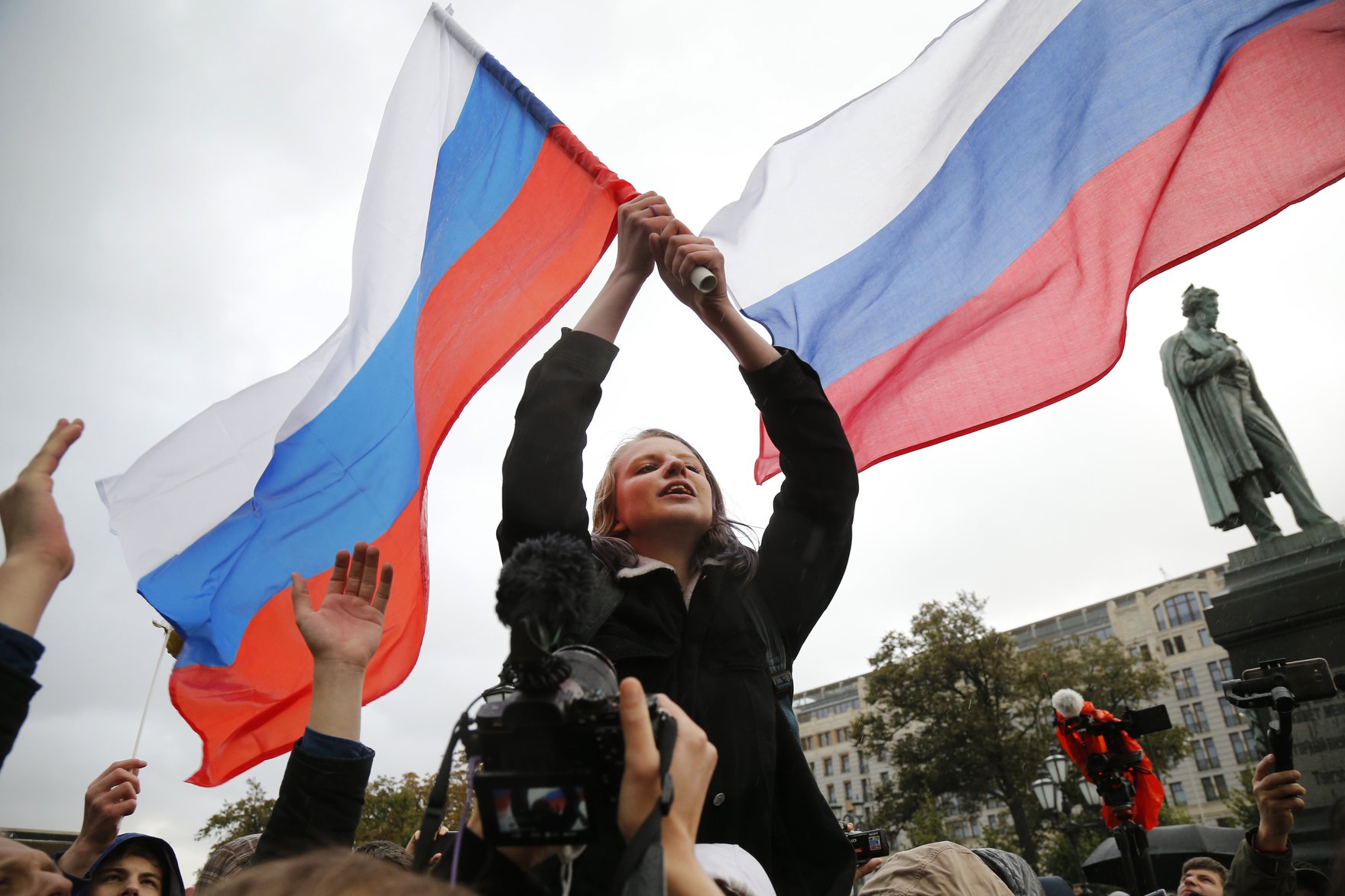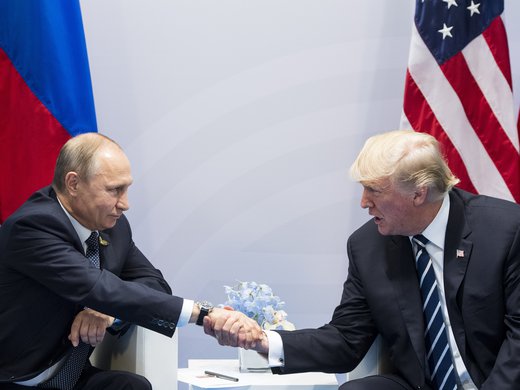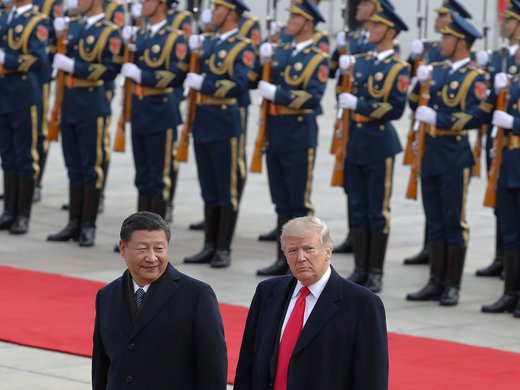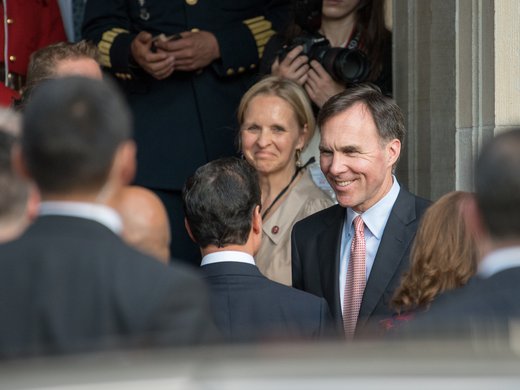A quarter century ago, the future seemed bright. The end of the Cold War — the 40-year ideological confrontation that pitted the capitalist economies of the Western alliance against the communist Soviet Union — held such promise.
But that promise wasn’t fulfilled. Why not? It’s a worthy question on the one-hundredth anniversary of the Russian Revolution, and an intriguing one, given US President Donald Trump’s curious deference to Russian President Vladimir Putin. With Canada set to assume the presidency of the Group of Seven (G7) in 2018, it is a question that Ottawa may soon have to address, too.
Initially, Russia’s slow transition to a post-Cold War liberal democracy seemed like a case of the post-Soviet blues, a by-product of a dramatic leap from one-party rule to a democratically elected government. And, yes, the economy was in chaos, but that was just the inevitable result of moving from central planning to a capitalist economy. Soon, informed opinion held, the economy would be growing as market-determined world prices, not Gosplan economists, allocated resources. Given time, Russia would join with other liberal democracies to improve the lives of its citizens and work with other members of the international community to cooperatively solve common problems.
Instead, there was no democratic institution building, just a change of labels on the same old system. In effect, the end of the Cold War did not represent a break with the past regime.
Rather than evolving into a “normal” society (the explicit goal of post-Soviet reformers), Russia looks increasingly authoritarian — almost Tsarist. Power is concentrated in the office of the president and Russia’s aristocracy-of-old has been replaced by plundering oligarchs. Meanwhile, as Yale history professor Timothy Synder points out, the masses of the people are offered the opiate of past Russian greatness and exceptionalism, even as life expectancy and social services decline, and drug abuse and alcoholism take their toll.
This outcome may well have been inevitable given that mutually assured destruction was the unspoken threat that had kept the ideological confrontation “cold.” The stalled — or stopped — transition to liberal democracy doesn’t fall on Russian shoulders alone, however. The international community made three major mistakes in managing Russia’s complex transition process.
Reliance on the IMF
The first mistake was in the design of international efforts to assist the Soviet Union in making the transition from central planning to a market economy. Very early in the transition process, G7 leaders turned to the International Monetary Fund (IMF) to lead the international response, but the Fund simply was not equipped for the task.
The IMF was created to assist its members with striking a suitable balance between financing and adjustment, thereby encouraging them to eschew beggar-thy-neighbour policies that, in the words of its articles of agreement, are ultimately “destructive of national or international prosperity.” To promote this objective, the IMF can only provide limited short-term payments support. Such support can help a country through modest difficulties.
In contrast, the problems confronting the Soviet Union were of an entirely different order. Transforming a centrally planned economy into a market economy requires structural reforms. This is not to say that macroeconomic stabilization wasn't a necessary condition for successful transition; it was. But macroeconomic stability was not a sufficient condition. It had to be supported by structural measures, including the development of a legal system, which Adam Smith identified as one of the key functions of government in his Wealth of Nations.
The IMF didn’t have the policy instruments necessary for promoting such structural measures. While the World Bank and the European Bank for Reconstruction and Development (the latter created in 1991 to support the Eastern European countries’ transition) had such instruments and, arguably, a longer-term focus, they only played a supporting role to the IMF’s lead.
Because it is based on a credit union model, the IMF lends on a short-term, revolving basis. Members pay into the Fund with the expectation that they will be able to temporarily draw on the collective resources if they need to. The policy reforms that the IMF asks of its members are designed to improve economic conditions in the member nation and to provide adequate assurance that it will be repaid.
Unfortunately, Russian reformers had limited political capital, and if it was used to promote macroeconomic goals, it couldn’t also be allocated to long-term structural reforms. That lack of political capital reflected the divided nature of Soviet society — while most citizens welcomed the prospect of political and economic reforms, many feared the uncertainty that came with the collapse of a system they had grown up in. There was a need, it was thought, to make the transition to a market economy in one leap.
While there was a clear political imperative in avoiding economic instability, the short-term rush to a market economy led to privatizations that put state assets in the hands of a few. And the IMF support may have created a facade of stabilization and reform that opened the door to the second mistake in managing Russia’s transition process.
Welcoming Russia into the G7
In 1998, Russia was welcomed into the G7. Here, too, the political imperative was clear: it was better to have the former Cold War adversary “in the tent” and part of the decision-making process, rather than outside, playing the role of disruptive observer. But Russia fit uncomfortably within the G7, which is based on consensual decision making. Because the existing G7 members shared basic political values and a common level of development, they had formed a working coalition that provided a modicum of leadership. The process was not always efficient or harmonious, but it worked.
In contrast, Russia did not share the same values or interests, making it more difficult for other members to coordinate among themselves on global issues and to agree on a common approach to dealing with their erstwhile partner. Most significantly, expansion of the G7 eroded the effectiveness of the policy coordination process and facilitated Russian dissembling with reforms.
Still, the rationale for cooperating with Russia was clear: a nuclear-armed, failed state would not be in the interests of anyone. But working with Russia to advance genuine political and economic reforms without undermining the effectiveness of the G7 — if at all possible — would have required a careful balancing of reforms and broad strategic issues.
Expansion of the NATO Alliance
With the benefit of hindsight, the third mistake made in managing Russia’s transition was the expansion of the North Atlantic Treaty Organization (NATO). Every scholar of the Cold War is familiar with George Kennan’s “long telegram,” an 8,000-word message to the US State Department in which he outlined a long-term strategy for dealing with an aggressive Soviet Union seemingly intent on expanding communism in Western Europe, if not around the globe. As a diplomat in the US embassy in Moscow during World War II, he had first-hand knowledge of Soviet policies and acquaintance with key figures. Kennan observed with alarm the steady expansion of Soviet influence in Eastern Europe following the war. His response was to propose a policy of containment. Rather than engage in direct confrontation with a nuclear-armed Soviet state, he argued that the United States should aim to contain further expansion. Containment was a long-term policy that required a long-term commitment from the United States. His policy was adopted and, 40 years later, bore fruit.
Far fewer observers may have heard of Nikolai Novikov’s long telegram. Novikov was Kennan’s alter ego in the Soviet embassy in Washington. He looked out over the postwar landscape and sought to put foreign, defence and international economic developments in perspective for his Kremlin masters. His assessment differed sharply from Kennan’s. He warned Moscow of Anglo-American imperial ambitions to divide the world into spheres of influence, and to bring the Soviet Union to its knees by injecting “American monopoly capital” into economies all over the world. It was a perspective that would take the shape of nationalism and dominate Soviet thinking for the next 40 years.
NATO expansion played directly into the hands of those seeking to exploit this resurgence of Russian nationalism. This is not to criticize states that sought NATO’s enlargement; having gained independence from Moscow, they were understandably anxious to avoid falling once again under Russian influence. But, in hindsight, the presence of a military alliance encompassing former buffer states on the very borders of Russia was kindling to the fire of Russian nationalism.
Contrary to the prospect of peaceful coexistence that the demise of the Soviet Union promised, recent events have revealed a new challenge in the relationship with Russia. In contrast to the Cold War nuclear confrontation that prevailed for more than four decades, this challenge is a threat to the political process in key advanced economies.
Lessons for the Future
So, what lessons can we take from past mistakes to better manage the challenge?
First, we need a long-term perspective. The transformation of the Soviet economy and polity to a market-based democracy was never going to be a short-term proposition. Macroeconomic stabilization may have been a necessary condition for successful transition, but it alone was not enough. Fundamental political reforms cannot be imposed from the outside. They must come from within, and this will take time. Similarly, reforming an authoritarian oligarchy will require genuine political reforms, which lie outside the control of external players. Perhaps the best that the advanced democracies can do is to establish a long-term framework for engagement with Russia that provides incentives for constructive engagement and clear, credible costs for disruptive behaviour.
Second, we need stable leadership to establish and enforce such a framework. The wider the coalition of democratic states aligned to preserve their pluralistic democratic institutions and enlightenment values, the better. Forging such a coalition requires effective leadership. In the Cold War, this leadership was provided by the United States. Going forward, the Trump administration’s seemingly conflicted relationship with the Kremlin cedes this role to others. The G7 could provide the collective leadership needed to mobilize others. The problem is that a revitalized G7 could be perceived as both a threat to Russia and a weakening of commitment to wider international fora, such as the Group of Twenty, whose cooperation in the framing and enforcement of international rules of the game is needed. This point underscores the importance of the next lesson.
Third, we need to avoid actions that could be used or manipulated to stoke Russian nationalism. The goal should be to create clear, consistent incentives for responsible behaviour — not to trigger adventurism.
What all this calls for is a new containment policy, one that recognizes the risks to democratic governments, mitigates those risks, and establishes a framework that, over time, promotes good behaviour. In this respect, democratic governments would be well advised to heed the five key elements of Kennan’s approach to containing Soviet expansion seven decades ago, namely to:
- study the problems that an authoritarian oligarchy poses to democratic governments with the “same courage, detachment, objectivity and same determination not to be emotionally provoked or unseated with it, with which [a] doctor studies an unruly and unreasonable individual”;
- inform their populations of the nature of the challenges they face because “there is nothing as dangerous or as terrifying as the unknown”;
- solve internal problems to give their populations “self confidence, discipline, morale and community spirit”;
- engage in constructive international leadership to guide others; and
- muster the “courage and self confidence to cling to [their] own methods and conceptions of human society.”
Mobilizing advanced economies behind these five actions to counter the threats posed to their democratic institutions will not be easy. It is a task made more difficult by the curious relationship between the Trump administration and the Kremlin and the seeming reluctance of the administration to provide steady, determined leadership in the councils of international affairs and global trade and finance. The reluctant hegemon creates a void in leadership that others will be quick to exploit.
Worryingly, however, there is no obvious substitute for US leadership. Germany and Europe are preoccupied with the challenges to internal coordination and cohesion revealed by the global financial crisis, which Brexit only magnifies. In any event, European economic interests, particularly in the energy sector, could make Europe a conflicted candidate. Meanwhile, Japan is likely to be absorbed in the search for a path to a post-pacifist constitution. That leaves Canada.
Prime Minister Justin Trudeau has said that he wants Canada to play a bigger role on the international stage. The G7 presidency, paired with this looming question about Russia, sets the stage. But to provide that leadership will require hard work and — just as the success of Kennan’s containment policy rested on close cooperation in international trade and finance, in addition to strategic policy — Canadian leadership will require a commitment to strengthening the full range of international institutions of cooperation. Is Trudeau prepared to do the work and make that commitment? In the absence of a fully articulated strategy, his words of Canadian ambition would soon ring hollow.



